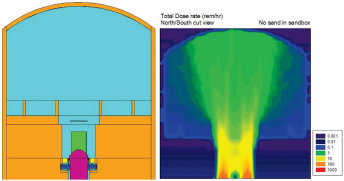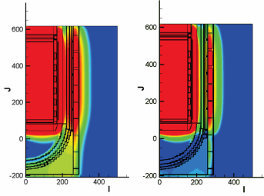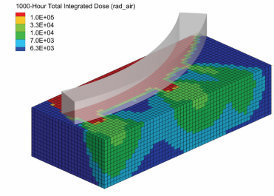Operators of nuclear power plants frequently face problems that require accurate characterization and analysis of radiation. The wide-ranging difficult issues that can arise can be far beyond the scope of typical radiation analyses, such as nuclear fuel design and accident analysis services. The Westinghouse team of radiation experts can answer the tough questions on radiation analysis, and Westinghouse offers a suite of products to assist with radiation and thermal measurements.
Westinghouse provides a full suite of radiation analysis services for pressurized water reactors (PWRs) and boiling water reactors (BWRs), including (but not limited to):
The radiation engineering and analysis team at Westinghouse has recently provided support for radiation-related licensing activities for:
Westinghouse offers products to support aging management and life extension of plant equipment. Refer to the separate flysheets for the following products:
Case Study: Sandbox Shielding Evaluation

Radiation traveling through the containment building during operation
During outage inspections, a customer identified sand leakage from the sandboxes that covered the reactor vessel inlet and outlet nozzles. Sandbox leakage increases the radiation coming from the nozzle inspection ports, resulting in a greater radiation dose to personnel and hardware, and potentially exceeding equipment environmental qualification (EEQ) limits. Westinghouse was contacted to determine dose rates during normal operation at various locations in containment under a variety of scenarios. Westinghouse rapidly completed the analysis and enabled the customer to justify continued operation with no interruption.
Case Study: AP1000 Lower Reactor Cavity Shield Design

AP1000 lower cavity post-shutdown radiation levels before and after shield design
In light water reactors, neutron leakage through the reactor pressure vessel activates the components in the reactor cavity.
This activation and the resulting radioactivity in the AP1000 would lead to potentially unacceptable dose rates in the area underneath the reactor during shutdown. With minimal impact to the existing design and no inhibition of operational airflow requirements, Westinghouse developed a shield that would provide operational and shutdown radiation shielding for the lower reactor cavity.
Case Study: Radiological Equipment Qualification

Radiation streaming into the auxiliary building through mechanical penetrations in containment
Westinghouse was contacted by a customer wanting to update the radiation doses associated with components in the auxiliary building under post-accident conditions, including radiation streaming from the containment building through electrical and piping penetrations. Westinghouse performed detailed calculations, considering all possible source terms, and provided the customer with doses applicable to selected components and zone maps depicting where radiation levels crossed critical thresholds.
Westinghouse applies state-of-the-art tools and techniques, and leverages many decades of industry leadership on every problem.
AP1000, LIFETIME and RadTrack are trademarks or registered trademarks of Westinghouse Electric Company LLC in the United States and may be registered in other countries throughout the world. All rights reserved. Unauthorized use is strictly prohibited.